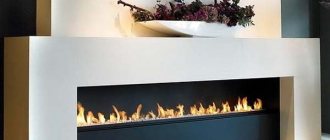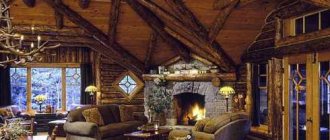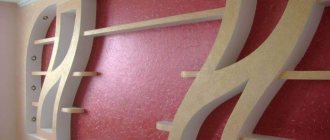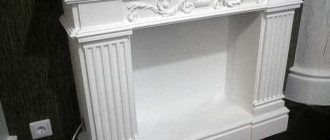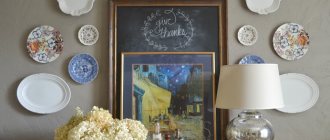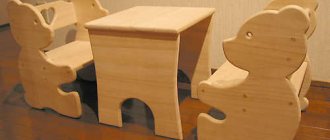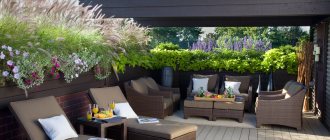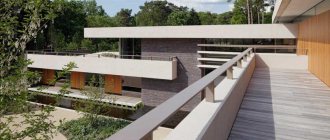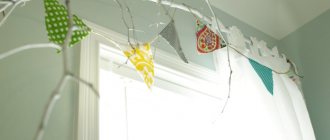As the owner of a private home, you have all the prerequisites for building a full-fledged fireplace. The main thing is to arm yourself with imagination or other sources of inspiration. At the same time, if a resident of an apartment building wants to install a traditional fireplace, his options are somewhat limited. Although even here it will be possible to find a way out of the situation by building an electrical device that in appearance differs little from the generally accepted design. The main advantage of the unit is that it can be installed anywhere in the apartment.
Artificial fire for the fireplace: salt lamp
The use of salt lamps in artificial fireplaces to recreate a decorative flame is beneficial and is considered an effective method. A salt lamp is a special lighting device whose lampshade is made of untouched salt crystal. In the inner part of such a lampshade there is a regular light bulb.
When the lamp is connected, the lampshade begins to heat up and release negative ions into the air.
They bind positive ions (from household appliances), which have a detrimental effect on human health, thereby helping to improve the well-being of home residents. The disadvantages of this method include the rather high price of salt lamps, and the advantages: realism, aesthetics and ease of installation.
By using lampshades of various colors, it is possible to effectively and very simply create a non-natural flame in your fireplace yourself. In addition, by using several lamps of different sizes at once, it is possible to create an imitation of a fire.
Beginning of work
Just as a theater begins with a coat rack, so a fireplace begins with a foundation. The site must be large enough to support your structure, i.e. mark it so that the width is approximately 5 centimeters greater than the width of the front base row, and the length is the size of the hearth. The foundation for the fireplace is poured separately from the foundation of the house.
You dig a pit a little larger than the foundation itself, about ten centimeters. The depth usually corresponds to the depth of the building itself; this is more technically correct.
To begin with, the bottom of the pit is lined with ten centimeters of crushed stone. A little more is possible, but less is not recommended. The crushed stone needs to be compacted properly. Then the formwork is made (a kind of box, only without a bottom, it was for this that we needed a “reserve” in size). Line the inside with roofing felt, this will protect the foundation from excess moisture. Lower the formwork into the pit and line the bottom with large stones. Cover the stones with crushed stone.
Now you can prepare the solution. The recipe must be followed exactly, since this is the foundation, that is, the basis, and negligence or hackwork is unacceptable here, as well as excessive savings. For the solution, mix cement and sand in a ratio of 1: 3, and dilute with water to a creamy mass. The foundation is poured in layers, and the interval between them is 1 layer - 1 day.
A fully poured foundation must be leveled, covered with plastic film and kept for seven days. After this, you can proceed directly to the laying.
DIY fireplace replica: TV instead of a fireplace
Another easy way to create a non-natural flame in a fireplace is to use a flat-panel LCD TV. But this method is considered the most expensive, since such equipment is expensive. Special LCD TVs have been developed that are produced specifically for artificial fireplaces.
They contain video footage of
:
- Playing tongues of flame;
- With smoldering coals;
- With a bright fire.
This recording goes on in the hearth of the false fireplace. Sometimes a TV can be supplemented with special optics, which consists of light filters. With its help, the image of fire will be the most expressive and voluminous. In addition to this optics, it is possible to use a mirror system. They are located in the corners of the fireplace, and the picture turns out to be more realistic; such lighting looks very beautiful. In rare cases, it is possible to use holographic installations. But this is not quite profitable.
Decorative firewood for the fireplace
In specialized salons you can find an abundance of options for such products; quite realistic firewood with a natural log pattern is available for sale. They can be plastic or ceramic. Any imitation, purchased or made independently, is intended to add realism to a decorative fireplace in order to help you feel all the splendor: home comfort, harmony, tranquility and warmth.
Imitation of plastic firewood or coals, has a fairly simple operating principle.
Coal and firewood are illuminated with red lighting. The light bulb can be located inside the firewood. Of course, this is not so reliable, but still. More expensive electric fireplaces are characterized by flickering or a picture of artificially transmitted tongues of fantastic flame. It is possible due to a special mechanism in which special elements rotate around the lamp, alternating with transparent and shaded areas. Such lighting can be located either behind the fake logs, or in the inner part.
Exactly the same lighting system can be used to achieve the effect of fire, using natural coal, which should be placed in the niche of a false fireplace. In this case, the backlight should be placed from the bottom.
Decorative false fireplace made of plasterboard
In modern apartments with interiors in modern or high-tech style, such a variation of the fireplace can be presented in the most unexpected way. Interesting solutions - a fireplace, as part of a furniture wall with books, or as an independent art object made of noble black glass.
A great option for a bedroom is a fireplace in a classic or Empire style. White planks with original stucco molding will add a touch of home comfort and warmth, and a decorative wood fireplace surround will fill the room with exquisite aristocracy. In addition, such an element, together with a mirror, can also serve as a kind of dressing table.
Among all the unusual options, the most popular is a false fireplace decorated with candles. They are used to decorate both mantelpieces and the firebox niche, selected by color and size, arranged in different combinations, placed in candelabra or simply placed on the floor.
A believable imitation of fire in a fireplace with your own hands (video)
So, in an apartment there is absolutely no possibility of installing a real fireplace. However, a fireplace, even if it is artificial, requires imitation of a realistic flame. You can do this yourself in several ways, described above.
For humans, fire has always been a symbol of purification, comfort, wealth, and is the personification of truth. It is not surprising that people still dream of crackling wood in the fireplace and want to watch the play of the flames. Not every home has the opportunity to install a real fireplace. But there are technologies with which you can make an imitation. To make the picture as realistic as possible, you can make decorative firewood for a fireplace with lighting yourself.
Artificial
It is not always possible to equip a fireplace that runs on natural wood, for example in an apartment. And in this case, apartment owners resort to various tricks, for example, installing fireplaces that run on electricity or biofuel. And for a better imitation of a real fireplace, the hearth can additionally be equipped with decorative firewood.
Ceramic firewood is made from heat-resistant ceramics. Ceramic firewood qualitatively imitates logs made of wood. This type of artificial firewood is intended for reusable use in biofireplaces. Ceramic firewood can be used directly near the fire, as it is characterized by resistance to elevated temperatures. Read an overview of types and photos of fireplace hearths on this page.
Electric firewood is equipped with LED lighting that simulates the effect of smoldering firewood. This type of firewood is used in fireplaces powered by electricity.
Simulated flame
To create an artificial fire in a fireplace with your own hands, you can use other people’s experience, rich in original ideas:
- the basis of the design is the TV screen;
- fire is simulated thanks to a three-dimensional image;
- the illusion of burning is created;
- cold fire and fan;
- fire effect from the steam generator;
- real logs with special lighting.
LCD screen as the basis of the design
A TV screen of suitable size is installed inside the false fireplace; ideally, an LCD screen is suitable. Then you need to find a video with the effect of flickering flames and with a sound reminiscent of the crackling of burning logs, connect it to the TV and enjoy the spectacle. The artificial fire for the fireplace is ready.
This method is considered the most accessible. Decorating your home with a fire hologram will not be difficult. The picture in 3D format is placed in a decorative fireplace so that its edges are invisible. The optical illusion occurs thanks to the LED backlight circuit.
Do-it-yourself artificial firewood for the fireplace will serve as an excellent addition to the decoration.
Create the illusion of fire
To realize the idea, mirrors are needed; they are placed in the fireplace and give the illusion of space. The angles between the glasses should be different. LED lamps are additionally used to design the virtual flame. The model works as follows: the fire of an electric fireplace is reflected from a mirror surface. Due to the fact that the mirrors distort the image, a three-dimensional effect is achieved, sparks seem to fly, and flames move in all directions. You want to admire such a spectacle for a long time, because the fire is very similar to a sparkling fire.
Cold Fire
The easiest way to create a decorative fire for a fireplace is to use an ordinary fan and scraps of red fabric. The process will not take much time. Triangular pieces of fabric are glued to the edges of the cardboard box. LED lamps of blue, red and yellow colors are mounted in the corners, and small mirrors and optical filters on the sides. The fan is installed so that the blown air flows move upward.
At the final stage, the product is placed in the fireplace and connected to the electrical network.
Fire created using a steam generator
Complex designs look most believable. Thanks to the water vapor generator, you get a stunningly beautiful hearth with an artificial flame. This requires patience and several components at once:
- small fan;
- ultrasonic fog generators, 3 pieces;
- container for water;
- distilled water;
- LED lamp, but a simple one will do;
- cardboard box.
Fog generators are placed at the bottom of the box. A ventilation device is attached to the side. Water is poured into a container and placed on top of the ultrasonic devices. The lamp is fixed above the fan. The structure is connected to the network.
Artificial fire produced using a generator turns out to be quite realistic.
Natural logs with backlight
You can use real logs as decorative firewood for a fireplace illuminated by LED strip. LEDs of yellow, red and white colors are suitable for this. The logs are beautifully placed on a shelf inside the fireplace, fastened together, and then randomly wrapped with LED strip. Flickering lights and natural wood complement the interior and look stylish and original.
If an electric fireplace is installed in the house, then it is better to choose special heat-resistant firewood. Artificial fireplace logs are made from ceramics. They are safe and durable. LED lighting is also appropriate here.
If you liked our site or found the information on this page useful, share it with your friends and acquaintances - click one of the social network buttons at the bottom of the page or at the top, because among the heaps of unnecessary garbage on the Internet it is quite difficult to find really interesting materials.
Today, many people have bio-fireplaces, traditional wooden hearths or potbelly stoves in their country houses. Some prefer an exact copy of historical models, others adhere to strict symmetry in the design of such a device. Fireplaces are decorated with carvings, bas-reliefs, sculptures, and various paintings. However, without natural firewood you will not warm your home or soul. Ensure the operation of stove equipment using natural fuel - wood.
photos
Examples of a fireplace dummy (photo ideas)
This is the fire I had assembled on the table:
You will need: 1) Chinese fogger from air humidifiers. 2) Power supply from a PC 3) Cooler from a PC 4) Halogen lamp 12 Volt red 5) Epoxy resin (a lot) 6) Silicone (any cheap one, a lot) 7) Halogen lamps 220 Volts (Flickering like a candle. Sold in stores .)
So…. I promised my daughter a “fireplace” for the New Year... Closer to the point, I discovered that the fireboxes available for sale are either not nearly realistic, or cost incredible amounts of money (2 thousand euros and more). I decided to do it myself..
The “fire” itself, after much experimentation, was made from (on Ali Express it costs about $3.5). I didn’t photograph the process, but it was simple - I made a metal container, attached a fogger and a cooler, and in the top cover there was a slot for the “steam” to escape.
Here's the diagram:
As is clear from the diagram, the fog formed by the fogger accumulates in a container above the water. The cooler pumps air and the mist escapes into a slot in the top cover. At the same time, it is illuminated by a halogen lamp in an orange-red color. It turns out to be “fire”. And above, the fog condenses, and since the lamp does not illuminate there, it turns out “smoke”... It is important that the structure is tightly covered with the top cover. Because fog is heavier than air, and if it has a “loophole”, it will pour out anywhere but up. I did this: I covered the edges of the resulting container with a thick layer of silicone, and on it I applied a piece of laminate spread with liquid soap (so as not to stick) and let it dry. I got a perfectly even elastic band around the edge. The top cover, made of a two-millimeter steel sheet and painted with nitro paint, fits tightly onto it.
After that, I started making the “fire” itself. I collected coals from extinct fires in the forest and coated them with construction silicone.
After drying, I removed the silicone molds and poured epoxy into them, which I had previously tinted red. (Since it itself is yellow, it turned out orange). After removing the mold, I sharpened the burnt logs, and then poured epoxy into the mold and inserted them back. I took out the finished “coals” and painted them with matte black paint from a spray can.
That's all, actually... I placed 220 Volt neon lamps on the top cover. (They flicker), after which he built a “bonfire”. I powered everything except the neon lights from the computer power supply - it was lying around because the voltage in it was unstable. And for my needs - just right. From it I got 24 Volts for the fogger, 12 for the cooler and halogen. All. All that remains is to build it all into the fireplace portal. (I'll talk about this later)
The dance of the flame fascinates with the changing dynamics of its bends. The pagan ideas of distant ancestors rise within us as forgotten memories. Ancestors who considered Fire a majestic god. And, despite the fact that we have domesticated and tamed this formidable natural phenomenon, the greatness of Fire makes us admire it again and again.
How pleasant it is in the evening in the twilight to immerse yourself in the contemplation of the flames, to feel the slightly bitter aroma of burning logs. But even the owners of private houses do not always decide to tear down walls, rearrange the attic and roof in order to install a real fireplace. And this is only the first half of the matter. During operation, you need to prepare firewood, remove ash, clean the chimney... And all these efforts are mostly aimed only at creating an atmosphere, because heating houses today is much more practical and less labor- and material-intensive.
And the atmosphere of a house with a fireplace can be completely recreated by an imitation of a flame. In this article we will talk specifically about, that is, about safe methods without an open large flame, in contrast to biofireplaces, which are also successfully used to decorate rooms, but have real fire.
Peculiarities
This material is intended for combustion in fireplaces and furnaces. With its help you can achieve the necessary heat, heat and lighting in the room. Loft, urban chic, country, eco and many others styles are more popular than ever. In them, a mandatory element of the interior is a lounge area, which is not complete without decorative fireplaces. Firewood for them can be purchased sawn or chopped.
The main property of the material should be a minimum amount of moisture. Most often, firewood has a standard size from 25 to 33 cm. Products are sold by weight, they are packaged or supplied in bulk storage meters.
With the right choice of fuel, a fireplace will bring an atmosphere of comfort and special magic to your home. Of all the currently known “food” for it, firewood is the most environmentally friendly option. When crackling, they create a charming smell, which has the best effect on human health.
photos
Making a fireplace
The location for the fireplace is marked directly on the wall and floor using a marker and a building level. This is done for ease of manufacture and assembly, and in addition it allows you to try on the main element, the electric firebox, to the parameters of the future portal.
Before mounting the frame, you can make a podium for a more impressive appearance of the entire product. The pedestal is made of brick or other blocks; it can be decorated with tiles, natural stone, that is, those materials that are suitable for finishing the foundations of buildings. A significant disadvantage of this addition is that it is completely static; such a pedestal will be almost impossible to move anywhere.
Once the necessary materials and tools have been prepared, you can begin making the fireplace portal. The operating algorithm is as follows:
The fireplace is ready and the heating part can be placed in it.
If the ventilation of the electric heating device itself is directed upward, then it makes sense to add a decorative chimney to the main portal. It is also made from metal profiles and plasterboard using the same algorithm as the main part of the body.
You will need to make a hole for ventilation in the upper tabletop of the portal where the decorative pipe is installed, and several small holes will be made on the sides of the fireplace pipe. For a better visual effect, such a pipe should be made up to the ceiling.
The location of the fireplace must be carried out.
It is best that it is made of wire with self-extinguishing insulation. It is desirable that the wiring be inserted into the fireplace portal body in a metal corrugated sleeve.
When installing the firebox, make sure that no foreign objects get into it. The power supply cord of the heating unit must not be placed under the floor covering or in the wall; access to it must be open.
Corner fireplace
There are no particular differences in the manufacture of a corner portal from the preparation of a front fireplace portal.
The only thing that changes is the shape of the frame and, accordingly, the shape of the entire body of the corner fireplace, or rather its part facing the corner of the wall. Also, the shape of the tabletop changes from rectangular to pentagonal. Everything else, both the manufacturing process and the assembly of the entire structure, is almost the same.
A corner fireplace differs from a front fireplace only in that it is more versatile when placed in small rooms, and also in the fact that a corner fireplace, when performing a heating function, provides less heat transfer than a front fireplace.
What can you heat with?
Any fireplace installation can be heated using briquettes, birch, beech or brushwood from any fruit tree, juniper branches, etc. Owners of country fireplaces believe that a wonderful alternative to charred logs - briquettes, which burn several times more intensely, give greater heat transfer, leaving a minimum soot and taking up minimal space in the house.
Ordinary firewood is much cheaper, even species such as alder and aspen, pine, pear, and apple. The dry matter mass in briquettes is minimal. When kindling, they are placed on paper or birch bark. Both materials ignite equally well. The duration of burning of a briquette will be much longer than that of a standard log, but the aesthetic beauty of the flames will be given by brushwood, stumps and roots.
The British are using an amazing secret to reduce soot in their chimneys. They throw a pinch of salt on the logs or briquettes during each laying. They are also often placed in a vertical position for a much more vigorous and energetic burn. With firewood in your supply, you will have half an hour for heating, and with briquettes - a full hour.
For open structures, increased fire safety requirements and good ventilation of the room are required. They serve primarily to heat the room and consume from 200 to 1000 m3 of air per hour. It is important to lay the floor around such a structure from non-combustible materials (tiles, stone, etc.). It is best to use beech and birch firewood for hornbeam.
For closed structures, you can even choose oak, aspen, or fruit tree logs.
In this case, the degree of fire hazard is reduced, and unpleasant odors of combustion products do not spread into the room. The only question remains about the chimney, which will become more clogged.
photos
Fuel briquettes
Briquettes are considered an excellent replacement for firewood and coal (they also belong to the category of hardwood). Such euro-firewood is suitable for boiler rooms, home Russian stoves, and fireplaces. They are produced from industrial waste, for example, woodworking, food: rice husks, various seeds, tyrsa, peat, sawdust, etc.
The briquette contains an adhesive element, which experts call a binder. To obtain maximum strength, the product can be strongly pressed and dried. The material does not pose any harm to human health.
Its main features are:
- high heat transfer due to humidity of 4-8%;
- high density 0.95-1 g/cm3, affecting the calorific value;
- ergonomic material that takes up minimal space in the house, utility room, basement;
- environmentally friendly (they do not pollute the environment);
- low humidity, which produces some soot.
Fuel briquettes are supplied in three formats: pini-key, roof and nestro with the same chemical composition. The greatest heat transfer comes from a product made from seed husks, the least from rice husks.
Pressed
The production of briquettes is not complete without a hydraulic or mechanical press. Such models do not contain harmful binders to health, have different shapes and resemble ordinary firewood. Experts recommend avoiding fireplace fuel made from waste from plywood mills. In some cases, the manufacturer uses not only pressing, but also firing of surfaces. Popular companies producing such materials are CF Nielsen, Pini-kay, RUF, Nestro, etc.
Pine
Pine is the best option for fireplaces; it will serve as fuel for open structures, but in small quantities. People are afraid to buy pine logs for only one simple reason: they are highly flammable and instantly flare up, increasing the risk of a fire. On the other hand, pine gives an exceptional aroma associated with comfort and a homely atmosphere. They contain a huge amount of resin, so you can’t do without crackling, smokiness, and sparkle.
Birch
Birch logs emit enormous amounts of heat when burned. You can spend hours watching the high, bright flames. As long as the fireplace is burning, pleasant aromas and special substances that can purify the air will not leave the room. An important advantage of birch firewood was its low price, but its disadvantage was the large and rapid accumulation of soot in the chimney.
Aspen
Aspen is one of those species that has soft wood, which means it burns well and practically does not spark. The density of the dry material is 0.37 g/cm3. The main advantage of such firewood: minimal smoke, incredibly bright fire. It will not only create a soulful atmosphere in the room, but will also “clean” the chimney pipe of soot due to the high column of combustion. Aspen can be combined with oak or birch logs in order to increase the combustion rate.
Oak
Oak has the highest heat transfer of all known species - 4.2 kWh/kg. The only negative is the difficulty of splitting oak firewood, which does not affect their high demand at all. They are hardwoods, give off a pleasant aroma, and are affordable.
Alder
Alder logs and branches can ignite instantly. Compared to other breeds, they emit less heat, but they burn soot excellently and clean chimneys. When burning, alder releases special substances into the air, which, among other things, effectively fight colds.
How to light a fireplace with glass?
A glass fireplace will retain its transparency and neat appearance if it uses a special type of firewood, even better decorative (models with lighting, ceramic products, etc.).
It's always nice to watch the dance of fire through huge glasses with wide viewing angles, in which soot does not appear immediately. The cleanliness and transparency of the glass surface is influenced by the quality of the fuel you choose.
Buy firewood with a moisture content of less than 20%.
Such dry material naturally exhibits an even flame, which means it reduces the risk of heavy smoke and soot formation. Conifers placed in the firebox, which spark, crackle and clog not only the glass “panorama”, but also the chimney itself due to its resin content, would not be the best solution.
photos
How to light a fireplace correctly?
You don't want to get burned after several fires, do you? To do this, you need to learn the technology of normal draft and how to properly reduce the volume of smoke in a stove or fireplace. While you enjoy the sonorous crackling of wood, a natural combustion product, carbon dioxide, is released into the air. Most of it goes into the chimney and out. But some of it still remains indoors. It is important to adjust your traction so as not to burn out during rest, sleep, etc.
It is important to use “fuel” with a minimum percentage of moisture, less than 20%. Ignition should be carried out in such a way that the temperature increases gradually. The source of smoke is bark, so it is best to use wood that has been pre-cleaned or rounded.
It is also necessary to systematically check the tightness and integrity of the heating system (stoves, fireboxes, fireplaces). Experts do not recommend closing the damper during ignition. Through a small sash or opening, the intensity of the draft will be adjusted.
Many people wonder what to do if both firewood and briquettes burn poorly. In this case, it is worth using additional materials for high-quality kindling: shavings, thin chips, branches, etc.
photos
Styles and solutions for portals
The portal for an electric fireplace can be:
- Classic - suitable for designing and decorating most rooms and rooms in houses and apartments, it has simple features, straight shapes that are combined with more elegant thematic decor;
- Country - for such a fireplace, environmentally friendly and natural materials are used, such as natural minerals, marble, granite, sandstone and other stone;
- High-tech - such a fireplace portal is based on materials such as transparent glass, steel, chrome surfaces, plastic and other modern materials;
- Modern fireplaces, just like classic ones, can easily be combined with any room and can partially overlap with the classical direction. Art Nouveau is characterized by the use of original forms, bright and contrasting colors.
An electric fireplace portal must be chosen or made correctly, however, many often make a number of mistakes and do not take into account some nuances:
Determine the correct and suitable style that will be used to make the fireplace portal and decorate the room, also pay attention to the height and dimensions of the structure. If a low design suits you, you can give preference to an English fireplace, while among more bulky designs, imitations of fireplaces in the style of Russian stoves are very popular; An electric fireplace will be lost if you deepen it too much or hide it in a frame; also, when choosing a hearth and portal, you need to take into account their size, as well as their combination with the area of the room
If you prefer the classics, then the firebox will occupy two-thirds of the portal’s height and half the width; Before you make a portal, you need to buy a suitable hearth, otherwise in the end it simply won’t fit the size of the frame or won’t match it in style.
How much do you need?
When choosing a budget or expensive option for fireplace equipment, an important criterion is the capacity of the firebox, how much wood will optimally fit into it. Dry, but not rotten, firewood should occupy no more than ¾ of the structure itself. If these are thick logs, it is enough to use 3-4 pieces, and if we are talking about birch, aspen, poplar logs, up to 10 pieces will be required.
Decorative firewood for a fireplace will be an original design option for the firebox and will bring an atmosphere of warmth and comfort to the interior. Modern designs are often not used to heat the room, being only an elegant design element. Electric versions and false fireplaces without a live flame look artificial and not aesthetically pleasing. The optimal solution for such hearths can be decorative logs, which will emphasize the notes of naturalness.
Decorative firewood for the fireplace is a high-quality imitation of smoldering logs. In a city apartment, installing a traditional design is impossible, so electric fireplaces are widely used. Despite the absence of smoke and the rapid supply of heat by the device, the desired perception of the fireplace is lost. Firewood replicas are used to add naturalness, providing a holistic and complete look.
Correct design will make the imitation as similar as possible to a classic wood-burning fireplace, hide unsightly details and improve the aesthetic appearance. Decorative firewood will help recreate a unique feeling of true comfort and warmth, complementing the visual perception of the composition on a subconscious level.
Main components of an electric fireplace
An electric fireplace will perfectly decorate the interior of an apartment
Creating an electric fireplace with a living flame effect yourself is a labor-intensive process. But he's worth it. It will brighten up more than one evening for you. First of all, before you start building this unit, you need to figure out what its main components are. It includes two main elements: the hearth and the portal. The first is an electronic system in which flame combustion occurs. The second is the frame where the firebox or hearth is placed.
There are a large number of options for building an electric fireplace on your own. But they are all united by these two elements, which are manufactured separately and then combined into one structure.
Types of materials
Artificial logs are presented in a wide variety of species. The material for production of products can be ceramics, stone, or plastic. For connoisseurs of natural textures, there are options made from ordinary wood, treated with special compounds.
Decorative firewood on a natural basis is used to decorate artificial structures and the surrounding space. The trend of environmentally friendly interiors occupies a leading position in interior design.
Logs are presented in the form of whole logs, chopped logs, or dies. These types of firewood for the fireplace are often created with your own hands. Real wood can contain various insects and mold, so special attention should be paid to the integrity and cleanliness of the wood structure.
At the moment of ignition and operation of the eco-fireplace, decorative elements should be removed from the stove space. The system runs on a special type of fuel. The logs can be permanently located in an electric fireplace or a false structure. When installing candles in an artificial dummy, you will need to pay attention to fire safety conditions.
The natural texture and palette of wood shades of decorative firewood for a fireplace, made by yourself, allows you to choose the most suitable option for an organic combination with the overall interior. Light tones of birch logs are appropriate in modern and classic design. The bright color of aspen is suitable for an unusual design as a contrasting detail.
Ceramics and stone
The fireproof properties of ceramic and stone imitation firewood make it possible to leave the dummy in the firebox while the bio-fireplace is operating. Exposure to fire does not have a destructive effect on materials. Ceramic products realistically imitate small details of logs, creating a natural effect.
Decorative accessories for a ceramic fireplace are presented:
- dummies of whole or chopped logs;
- imitation wood with a fire-burnt texture;
- decorative coals;
- products in the form of cones, branches.
From a distance, it is difficult to distinguish objects from natural elements. The properties of the material make it possible to accurately recreate copies. Ceramic wood-burning fireplace decorations are fireproof due to the fire resistance of ceramics. Even when exposed to high temperatures, pine cones and decorative branches will not catch fire.
The service life of the products is quite long. If ceramic models are fired regularly, structural damage may occur over time. It is important to consider the quality of the product. Cheap options are susceptible to rapid spoilage. High-quality products, made in accordance with technological standards and regulations, can serve for several years.
Admirers of environmentally friendly materials will appreciate imitation stone firewood. The filling is carried out directly in the firebox area. The flames of living fire from biofuel structures look impressive when passing through stones.
Combustion products in this version of the fireplace are not emitted, so no chimney installation is required. Variations of the device allow you to implement unusual interior solutions without much effort.
Non-standard options
Modern fireplace appliances are created on the basis of innovative technologies. The flickering of the fire is achieved using electrical impulses. An original option could be the projection of a flame in a three-dimensional graphic image using optics and lighting effects.
Decorative firewood for a fireplace with lighting is the easiest way to decorate the firebox. Products are made of ceramics and plastic. The material lends itself well to processing, allowing a high-quality imitation of wood texture. The cost of plastic products does not require large investments and is available to a wide range of consumers.
The burning effect in electric fireplaces is achieved by equipping the wood-burning elements with LED lighting. The dummy looks very realistic, creating the appearance of hot coals with a flickering flame. There is a three-dimensional image on the fireplace screen, which in some models of electric fireplaces is complemented by sound. Artificial fire will advantageously complement the dummy firewood, enhancing the visual imitation of the flame.
Decorative firewood with lighting is widely used to decorate false fireplaces. The structures are made from various materials. A stylistic solution may include decorating the structure with candles, natural materials in the form of branches, cones, and artificial leaves. The firebox area is often filled with natural wood and decorative stones, simulating a hearth.
Decorative
Decorative firewood and new technologies will help you create a cozy home atmosphere, relaxation and aesthetics at the same time. These can be processed natural logs, ceramic branches that completely imitate wooden, plastic models, etc. You can use whole logs, logs, slightly charred saw cuts, fir cones and beautiful branches. Reminiscent of natural wood as much as possible, firewood often comes with backlighting or a 3D projection.
An electric fireplace is also considered an important object in the design of a classic or modern interior, for which, accordingly, electric firewood is used. The combustion simulation looks truly impressive.
Ceramic firewood with a burnt effect looks stylish. Heat-resistant ceramics exhibit smoldering when burned. It’s practically indistinguishable from the real process! Such products are made as close as possible to real wood in the color of birch, alder, aspen, etc. In specialized stores you can also find charred ceramic logs.
To create a cozy atmosphere, it is recommended to purchase real firewood with spectacular lighting. Including, it can be an LCD screen as the basis of the design. The main advantage of such models is fire safety. You will be sure that not a single spark will cause a fire.
